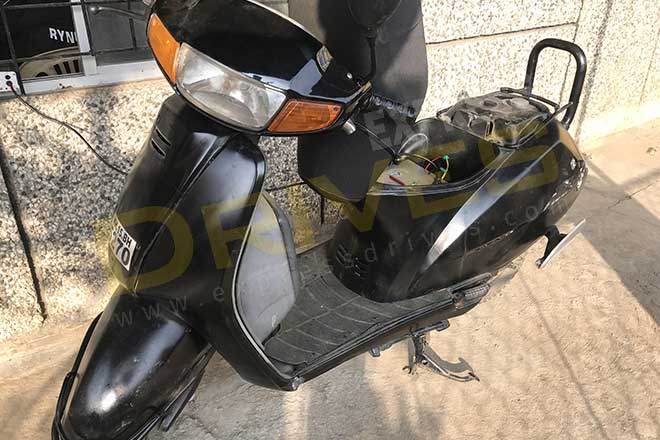The aforementioned scooter is loosely based on the Honda Activa. In the sense, the body as well as chassis are from the Activa. Onkar Sonawane, Mayur Shelar and Dhaval Tagare, the founders of E-mmortal Automotive, brought this scooter at scrap value and started working on retro-fitting an electric powertrain. Where did they get the latter? With a couple of friends (engineering college pass-outs), Onkar and his team set about building this scooter. They imported parts like the battery cells, controllers from China. However, the battery management system is from Taiwan and sometimes from Japan, depending on which one has better quality and lower procuring costs. So far, E-mmortal Automotive has made more than four of these prototypes and these run in Nashik. So, lets see what is the big deal about this electric scooter.
The basics and “engine”
The body of the scooter has been kept nearly intact. The kerb weight has gone down from 110kg to just 70kg now. Onkar and his team removed the engine and then went on to assemble the battery and other components. The swingarm has got some modifications to it as well. Other parts are exactly like the stock vehicle.
A 24ah li-ferrophosphate battery is used. This one has a 40-degree operating temperature and the team tells us that it is the optimum range. A li-ion battery has a higher 80-degree operating temperature, thereby making cooling the cell pack an issue and will also add weight. The team has managed to put together a 1000W battery and this one makes around 5hp of power and 9Nm. This is more than enough for what will essentially be a city run-about. The range? 90km in eco mode and 80km in power. Yes, there are two associated modes, activated through a button next to where the thumb starter (redundant) is. You twist the key to the on position and the e-Activa is good to go. The top speed in power mode is 60kmph and in eco at 40kmph. This battery pack is swappable and weighs 12kg. The charging time quoted is 4hrs, with a regular socket. With the fast charger, the charging time reduces to just 2.3hrs.
The good news is that this is a retro-fittable kit. Conversion of your regular petrol-powered scooter to electric will take around three days and Rs 40,000 (excluding cost of the donor vehicle). ARAI-approved parts and kits are used by the team. The still-in-development part? ARAI is yet to certify this entire exercise. This is where, Onkar says, they need sponsors. A vehicle certification will cost them close to Rs 25 lakh. Once it is done, more mass conversion of these vehicles can be achieved. Moreover, the team will then be able to endorse the same on the RC copy of the vehicle. On being asked their future plans, Onkar says that they aim to get this ARAI certification, a proper meter console that displays the range and developing more such vehicles. An all-new electric two-wheeler is also on the cards, with India-made batteries and cells used in it. At present, the battery charge is measured through an ammeter and when it reaches 57 volts, it means the battery has discharged fully. A full battery will sweep the needle till 69 volts. While the initial construction seems a bit crude, we are confident that with proper guidance, resources and encouragement, we might see a home-grown Tesla in E-mmortal Automotive.
